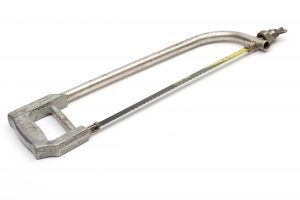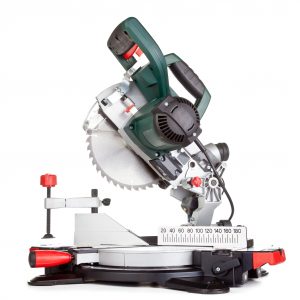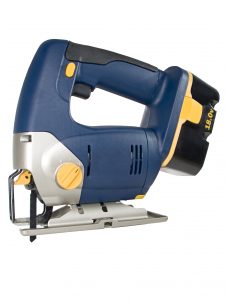
If you can’t tell us what a miter, hand or jig saw is used for, this video is your how to for using each of these types of saws. Whether you choose to DIY a project or hire a guy, you’ll need this guide.
Materials Required:
- Breathing protection
- Saw: handsaw, compound miter saw or jig saw
- Safety glasses
- Gloves
Sawing Steps:
- Handsaw: A handsaw is the most basic of saws. It’s most often used for fine wood working projects like joinery or dovetails. Handsaws start at around $30.
- Compound miter: A compound miter saw cuts angles across the wide face of a piece of wood, making it essential for almost any carpentry project. A good miter saw can cost upwards of $1,000.
- Jigsaw: The jigsaw is primarily used for cutting curves, stenciling designs and creating shapes. The key to using a jigsaw is control. Use a sharp blade and move it slowly to ensure you get a high-quality cut. Jigsaws range from about $25-$400.
HomeAdvisor Tips:
Make sure the blade is moving at full speed before starting to make your cut.
Make Perfect Saw Cuts
Most woodworking projects require some type of sawing. For many do-it-yourselfers, this is the most satisfying part of the project. Sawing brings out the smell of the wood, and there is something satisfying about generating a big pile of sawdust. However, the fun can end abruptly without the proper safety measures, so each saw project should start with the following:
- Goggles – Don’t flip the on switch if the goggles are not in place.
- Breathing protection – Even when machines have sawdust outlets, it helps protect the lungs when the operator wears a basic safety mask.
- Secure operation – Make sure that the machine cannot get away from you – bolt bench models, use saw feeds when appropriate, and keep the machine safety shields in place.
Once all the safety concerns are dealt with, you are ready to choose the right saw for the job.

Using a Handsaw
Handsaw use is pretty basic and intuitive, but woodworkers can achieve better cuts with less effort by following a few tricks.
- Cutting with the grain is much easier than cutting across it. When cutting with the grain, a craftsman can use a rip saw. The larger teeth on this saw make short work on a cut in the direction of the grain. However, a cut across the grain requires a crosscut saw. A rip saw will tear apart the wood at a cross-grain cut. On the other hand, while a crosscut saw can be used to cut with the grain, it will take twice as long as the rip saw.
- The saw only cuts moving forward, not backward. An efficient motion comes by simply pulling the saw on the backstroke and then applying the saw to the center of the cut on the forward motion, all the while slowly tilting the saw further forward as the saw moves through the wood. This motion is the most efficient way to make a cut.
- Keep the blade sharp. This ensures efficient, clean cuts and helps keep the wood from binding. Another way to makes sure the blade moves smoothly through the wood is to keep the surface pristine through occasional lubrication.
For big jobs, consider using a table saw. Like a hand saw the table saw has both rip and crosscut blades. Work guides ensure beautiful, precise cuts. However, this machine is arguably the most dangerous type of saw. Don’t let your hands get anywhere near the blade. Also, do not stand directly behind the blade. This is where the table saw throws the work when it binds. Using the work holder helps prevent this from happening.

Using a Miter Saw
A miter saw is perfect for making a series of crosscuts at controlled angles. It is an essential tool for projects like making a fence where many joists must be cut to length. Unlike a table saw, a miter saw does not necessarily need to be secured to a bench. TIP: Do not move the wood or approach the circular blade with your hands while the blade is moving. This saw can also throw work back toward the operator.
The operator must be cognizant of the depth the miter saw can achieve, which is approximately half the blade radius. By making two cuts, the operator may double the depth of the cut, but no more.
An even more portable version of the miter saw is the skilsaw, which also has a circular blade, but not the table. Operators must always keep in mind what could happen if the skilsaw slips. Although a protect guard automatically slips into place, the machine should still be kept away from feet and legs. It should never be operated above shoulder level.

Using a Jigsaw
A jigsaw allows craftsmen to make freeform cuts. Blade choice is everything with the jigsaw and so the machine should be chosen with a quick blade switch system. In general, a comparatively narrow blade with smaller teeth will allow the tightest-radius cuts. However, the narrow teeth will move more slowly through the wood, particularly harder types of wood like oak or walnut, and the narrower blade will be more susceptible to breaking.
The blade guard makes the jigsaw a very safe device. However, the operator still needs to make sure not to move the wood too quickly through the blade. This can break the blade or cause heat scorches on the wood.
No Comments Yet
Sorry, comments for this entry are closed at this time.

